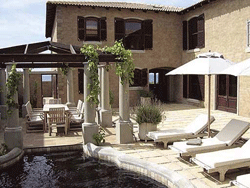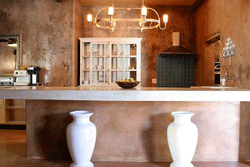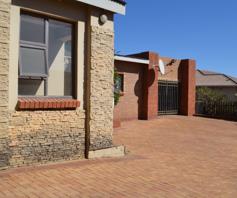 Although it is largely traditional in its outlook, the Provencal style of decor is not for the faint hearted – it combines vivid colours that evoke the warm tones present in the Provencal countryside, including golden yellows, vivid indigos, sky blues, deep reds and russets, and bright, creamy greens.
Although it is largely traditional in its outlook, the Provencal style of decor is not for the faint hearted – it combines vivid colours that evoke the warm tones present in the Provencal countryside, including golden yellows, vivid indigos, sky blues, deep reds and russets, and bright, creamy greens.Its muse
Inspired by its namesake, Provencal decor originates for Provence, a region in the south-eastern corner of France. It is world renowned for its balmy Mediterranean weather, spectacular landscapes, rich history and unhurried pace of life. If you have ever visited the region, you will understand its charm – the beauty of its villages and countryside, the splendour of its sunlight, the sweetness of the air and the plethora of evocative colours that are indeed a feast for the eyes. Provencal décor combines all of these attractions and unique characteristics in an attempt to capture the spirit of Provence's countryside appeal.
Architectural features
 Provencal décor is underpinned by rustic architectural features, such as stone walls and floors, distressed, raw wooden ceiling beams and timbers, and irregularly plastered walls. The walls are really a main focal point – they are often lime-washed or plastered with a rough finish to capture the exterior construction of a traditional Provencal farmhouse. For a more modern finish, you can create the same ambience by applying textured or stucco paint to the walls instead, or perhaps giving them a colourwash in natural stone-inspired colours.
Provencal décor is underpinned by rustic architectural features, such as stone walls and floors, distressed, raw wooden ceiling beams and timbers, and irregularly plastered walls. The walls are really a main focal point – they are often lime-washed or plastered with a rough finish to capture the exterior construction of a traditional Provencal farmhouse. For a more modern finish, you can create the same ambience by applying textured or stucco paint to the walls instead, or perhaps giving them a colourwash in natural stone-inspired colours.Floors
 As with the majority of materials used in Provencal decor and architecture, materials used for flooring should be natural, such as solid wood, stone or terracotta tiles. Flagstone, brick and clay tiles are common in Provencal homes. Modern equivalents include unglazed quarry tiles in colours ranging from pinkish red to honey to deep brown. Other considerations comprise flagstone, slate, marble, brick, terrazzo or ceramic tiles in a definitive French pattern of black-and-white or red-and-white checks. Solid wood flooring in panels or parquet will also go nicely with this style, as would roughly textured carpeting, such as sisal for example. For additional underfoot comfort and visual appeal, floors are accented with Oriental rugs for a rich and opulent feel.
As with the majority of materials used in Provencal decor and architecture, materials used for flooring should be natural, such as solid wood, stone or terracotta tiles. Flagstone, brick and clay tiles are common in Provencal homes. Modern equivalents include unglazed quarry tiles in colours ranging from pinkish red to honey to deep brown. Other considerations comprise flagstone, slate, marble, brick, terrazzo or ceramic tiles in a definitive French pattern of black-and-white or red-and-white checks. Solid wood flooring in panels or parquet will also go nicely with this style, as would roughly textured carpeting, such as sisal for example. For additional underfoot comfort and visual appeal, floors are accented with Oriental rugs for a rich and opulent feel.Lighting
 Traditional Provencal architecture is designed to allow as much natural light in as possible, with the inclusion of trademark multi-panelled French doors and windows. As a result, artificial lighting takes a bit of a backseat to other design elements. Nevertheless, it is still a distinct design feature and comprises iron or brass lanterns or candelabra with a distinctive country charm. The metal fittings are large, curved and traditional, but not ornate. Instead they boast a simple elegance that can be spruced up with the addition of delicate glass or crystal droplets that will catch the light.
Traditional Provencal architecture is designed to allow as much natural light in as possible, with the inclusion of trademark multi-panelled French doors and windows. As a result, artificial lighting takes a bit of a backseat to other design elements. Nevertheless, it is still a distinct design feature and comprises iron or brass lanterns or candelabra with a distinctive country charm. The metal fittings are large, curved and traditional, but not ornate. Instead they boast a simple elegance that can be spruced up with the addition of delicate glass or crystal droplets that will catch the light.Colours
The colour palette is influenced by what is found naturally in the region of Provence. This would include colours derived from local stone and clay, natural hues present in the earth such as dove grey, taupe, dust and mustard, as well as the lusty and vibrant colours inspired by the natural landscape and sunlight, which would include lavender, sunflower yellows, burnt orange, olive greens, as well as cobalt and sky blue. Vincent Van Gogh was especially mesmerised by the Provencal countryside and these hues are vividly evident in his artwork.
Fabrics
 Traditional Provencal fabrics reflect the colours and charm of the region. Their history dates back to the 17th Century, when cloth from India arrived via ship in the port of Marseilles. This inspired local craftsmen to produce fabric with similarly rich colours and patterns. They were originally called les Indiennes, but over the ages they have been localised to reflect patterns, plants and animals typical of the Provencal landscape, such as olives, lavender, sunflowers and chickens. Lace is another popular cloth used in typically Provencal decor – it is used as a screen for multi-panelled windows and to accent stark white bed linen and drapes. To add a touch of glamour, Damask prints can also be included, and floral, checked and Toile fabrics can be used to create a luxurious, yet comfortable look. For more formality, Aubusson tapestries can cover throw pillows and be used for upholstering dining room chairs.
Traditional Provencal fabrics reflect the colours and charm of the region. Their history dates back to the 17th Century, when cloth from India arrived via ship in the port of Marseilles. This inspired local craftsmen to produce fabric with similarly rich colours and patterns. They were originally called les Indiennes, but over the ages they have been localised to reflect patterns, plants and animals typical of the Provencal landscape, such as olives, lavender, sunflowers and chickens. Lace is another popular cloth used in typically Provencal decor – it is used as a screen for multi-panelled windows and to accent stark white bed linen and drapes. To add a touch of glamour, Damask prints can also be included, and floral, checked and Toile fabrics can be used to create a luxurious, yet comfortable look. For more formality, Aubusson tapestries can cover throw pillows and be used for upholstering dining room chairs.Furniture
 Handcrafted and decorative, yet simple and practical, are key when it comes to furniture used to decorate Provencal-inspired interiors. The tradition of Provencal furniture making dates back to the 18th and 19th Centuries, when French artisans were drawn to Provence to trade ideas across the Mediterranean, at the region's ports. The cross-cultural influence resulted in furniture made with skill and imagination. The most well-known piece is of course the traditional armoire, a general-purpose cupboard used for clothes, food or linen and traditionally made from Walnut. Simple lines characterise Provencal furniture, as found in traditional pieces such as box-framed beds, rush-seated benches and bentwood chairs. Soft and luxuriously upholstered armchairs and sofas are also typical of the region.
Handcrafted and decorative, yet simple and practical, are key when it comes to furniture used to decorate Provencal-inspired interiors. The tradition of Provencal furniture making dates back to the 18th and 19th Centuries, when French artisans were drawn to Provence to trade ideas across the Mediterranean, at the region's ports. The cross-cultural influence resulted in furniture made with skill and imagination. The most well-known piece is of course the traditional armoire, a general-purpose cupboard used for clothes, food or linen and traditionally made from Walnut. Simple lines characterise Provencal furniture, as found in traditional pieces such as box-framed beds, rush-seated benches and bentwood chairs. Soft and luxuriously upholstered armchairs and sofas are also typical of the region. Pictures
PicturesImages courtesy of:
- Avignon Guesthouse
- Auberge Provence
- Le Chatelet
- Kitchen Designs
- Chestnut Grove Interiors
- Ambiente Luce
For more information click here to visit the Avignon Guesthouse website.
For more information click here to visit the Auberge Provence website.
For more information click here to visit the Le Chatelet website.
For more information click here to visit the Kitchen Designs website.
For more information click here to visit the Chestnut Grove Interiors website.
For more information click here to visit the Ambiente Luce website.
Property News
Click here for more property news articles.
Need a blog?
Start your own blog with a free blog from 24.com.








